Scaling GitHub Actions with Kubernetes: A Guide to ARC Deployment
Table of Contents
Let us walk through setting up an Actions Runner Controller (ARC) for GitHub in a Kubernetes cluster. This will enable running continuous integration and continuous deployment (CI/CD) pipelines using GitHub Actions on our infrastructure, or on cloud based Kubernetes.
First, we’ll introduce a bit of the terminology:
-
Runner a container which runs code in response to a trigger. They may be used to test, build and deploy code, as well as far more creative use-cases.
-
Workflow one or more jobs.
-
ARC a Kubernetes implementation of GitHub runners built by the open-source community. It allows scaling to workload requirements.
Self-hosted GitHub Runners function by polling GitHub for new workflows within a scope. Workflows can be triggered by GitHub events such as pushing code, merging code, publishing a version, or manually via GitHub’s Web UI. Workflow definitions are YAML formatted and live in .github/workflows/ within a repo.
Using this site as our continuing example, ARC will be implemented to build our website image, deploy the image to a registry and patch our Kubernetes deployment. In practice, we git push to main branch and the website will be updated automatically.
In the last three posts the deployment process has been via docker build, docker push and some kubectl commands.
We will be continuing on from the previous post and the resulting repo.
Example#
Checkout the end result in GitHub
References#
Tech Stack#
- ARC
- K3s
- Ubuntu Linux
- Helm
Bring Your Own#
- Host running Ubuntu Linux
- e.g. VirtualBox VM, Bare metal host, Virtual Private Server (VPS), WSL2
- K3s installed on host
- Helm
Steps#
Setup GitHub#
First, a note on security. GitHub actions can be used to expose secrets and other sensitive information. A repo contributor with push permissions can insert a workflow definition. The risks when self-hosting are higher than when using GitHub’s platform as information about our infrastructure may be exposed as well.
This is particularly relevant for adding runners at Github’s organisation or enterprise levels.
See GitHub documentation for details.
Securing Public Repos#
Adding runners to public repos presents an attack vector.
A bad actor may fork a public repo, add a workflow definition containing a merge request trigger, then submit a pull request to the original repo resulting in the rogue workflow being executed on a runner of the original repo.
To mitigate this we:
Set the repo to require approval for workflows from outside collaborators#
Click Settings in the GitHub repo.
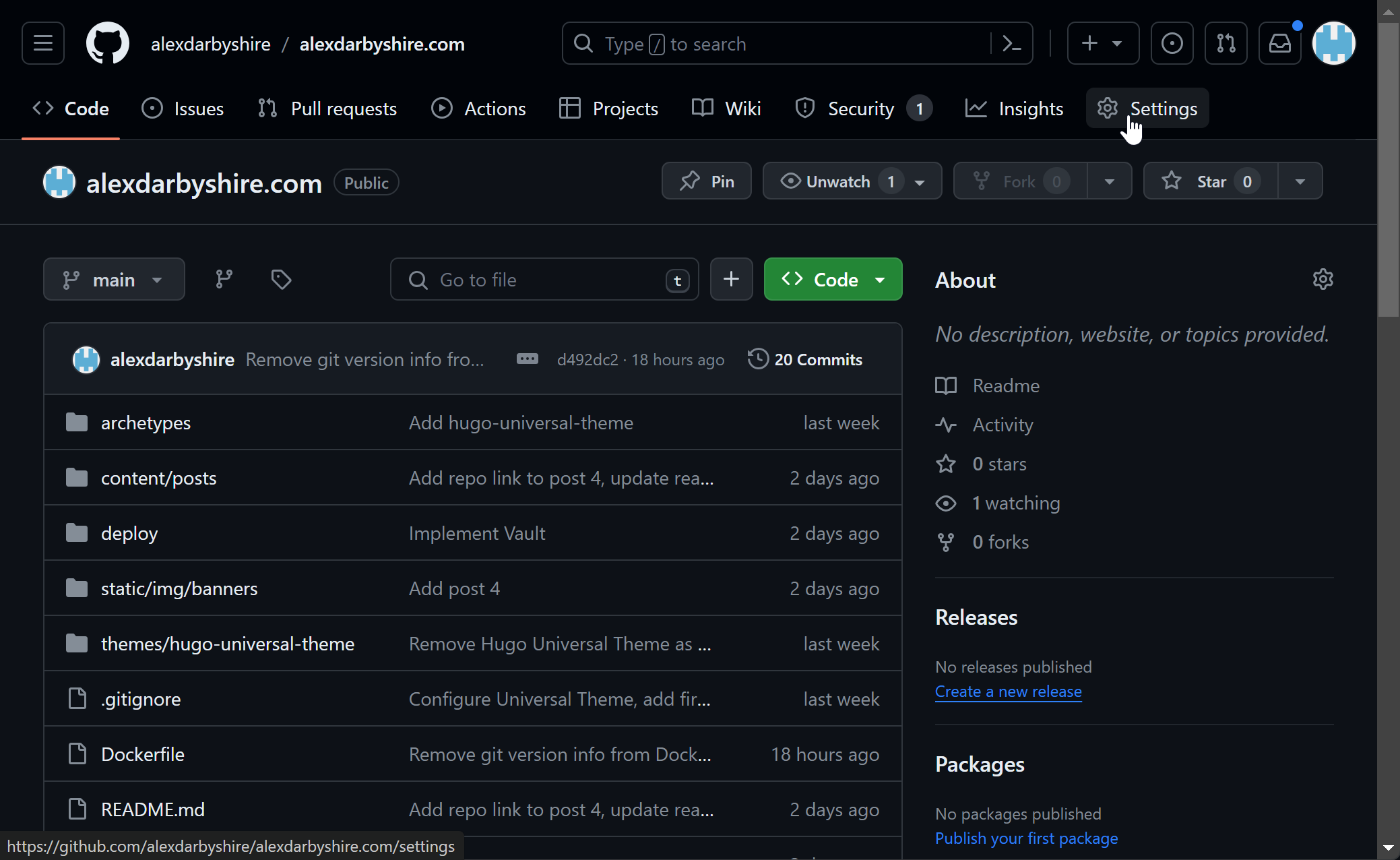
Click Actions then General.
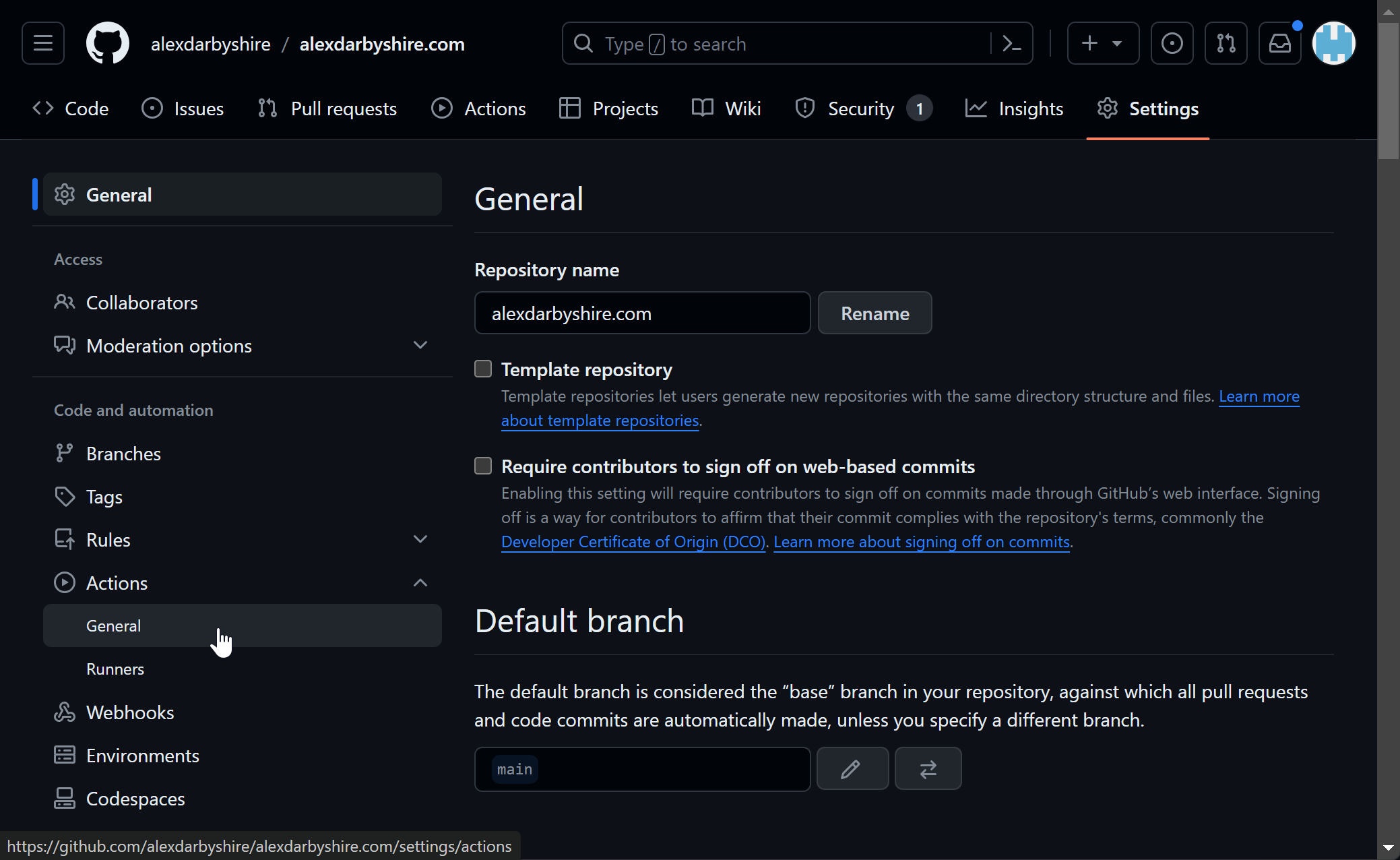
Select Require approval for all outsidde collaborators and save.
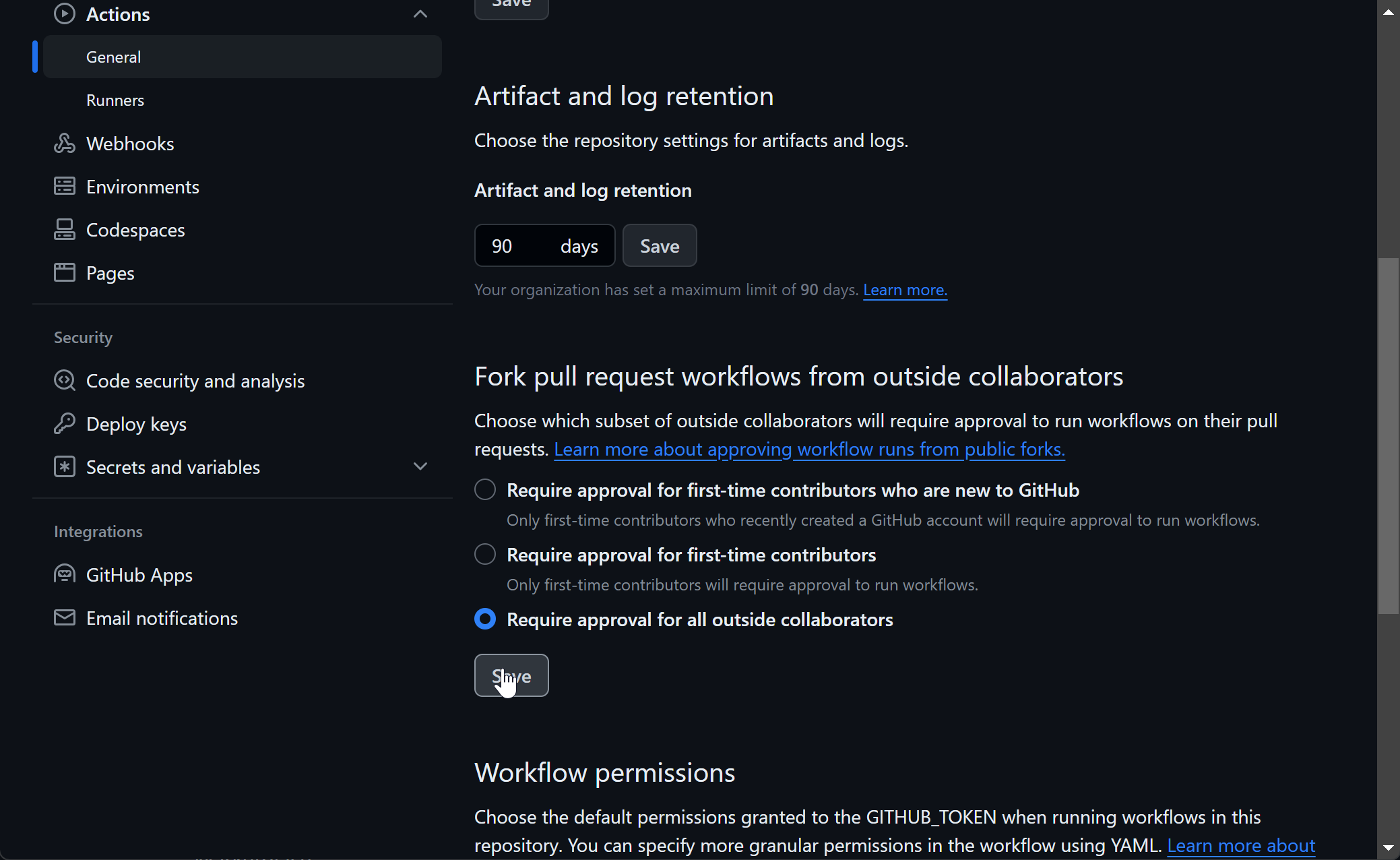
Setting up a GitHub Token#
Create a personal access token (classic), see GitHub’s Manage your Personal Access Token documentation.
Add repo permissions for a repository based runner.

Or if for an organisation, add admin:org permissions.
Note the token, we will add it as a secret in a few steps.
Install and Configure ARC#
For the sake of reduced complexity, we have done everything in Kubernetes default namespace. In non-test environments, namespaces should be used to isolate resources in accordance with the principle of least privilege.
Add Kubernetes Service Account#
This step is relevant to use-cases requiring management of Kubernetes through GitHub actions, where the Kubernetes cluster has no public facing API.
In our case, it enables us to patch our deployment from the GitHub workflow. Without defining and attaching a specific service account, the default runner service account has zero permissions.
Were this production we might abstract this away with an API service or use additional tools to prevent the need for these permissions being granted to runners.
Create a file deploy/rollout-auth-service-account.yaml with contents:
apiVersion: v1
kind: ServiceAccount
metadata:
name: rollout-auth
namespace: default
---
kind: Role
apiVersion: rbac.authorization.k8s.io/v1
metadata:
namespace: default
name: restarter
rules:
- apiGroups: ["apps", "deployments"]
resources: ["deployments", "replicasets", "pods"]
verbs: ["get", "patch"]
---
apiVersion: rbac.authorization.k8s.io/v1
kind: RoleBinding
metadata:
name: rollout-binding
namespace: default
subjects:
- kind: ServiceAccount
name: rollout-auth
roleRef:
kind: Role
name: restarter
apiGroup: rbac.authorization.k8s.io
Add ARC Helm Values#
This is required to allow us to use docker-in-docker, and to attach the service account from the previous setup. With the benefit of hindsight, would be better to use kaniko to build images thereby avoiding exposing the docker socket and its privileges to the runner.
Add file deploy/helm/arc-runner-values.yaml with contents:
## githubConfigUrl is the GitHub url for where you want to configure runners
## ex: https://github.com/myorg/myrepo or https://github.com/myorg (personal accounts appear to be limited to repos level only)
githubConfigUrl: "https://github.com/alexdarbyshire/alexdarbyshire.com"
## githubConfigSecret is the k8s secrets to use when auth with GitHub API.
githubConfigSecret: github-alexdarbyshire-com-pat
## For a pre-defined secret using GitHub PAT, the secret needs to be created like this:
## > kubectl create secret generic github-alexdarbyshire-com-pat --namespace=arc-runners --from-literal=github_token='ghp_your_pat'
## maxRunners is the max number of runners the autoscaling runner set will scale up to.
#maxRunners: 2
## template is the PodSpec for each runner Pod
## For reference: https://kubernetes.io/docs/reference/kubernetes-api/workload-resources/pod-v1/#PodSpec
template:
spec:
serviceAccountName: rollout-auth #Here we add our service account
initContainers:
- name: init-dind-externals
image: ghcr.io/actions/actions-runner:latest
command: ["cp", "-r", "-v", "/home/runner/externals/.", "/home/runner/tmpDir/"]
volumeMounts:
- name: dind-externals
mountPath: /home/runner/tmpDir
containers:
- name: runner
image: ghcr.io/actions/actions-runner:latest
command: ["/home/runner/run.sh"]
env:
- name: DOCKER_HOST
value: unix:///run/docker/docker.sock
volumeMounts:
- name: work
mountPath: /home/runner/_work
- name: dind-sock
mountPath: /run/docker
readOnly: true
- name: dind
image: docker:dind
args:
- dockerd
- --host=unix:///run/docker/docker.sock
- --group=$(DOCKER_GROUP_GID)
env:
- name: DOCKER_GROUP_GID
value: "123"
securityContext:
privileged: true
volumeMounts:
- name: work
mountPath: /home/runner/_work
- name: dind-sock
mountPath: /run/docker
- name: dind-externals
mountPath: /home/runner/externals
volumes:
- name: work
emptyDir: {}
- name: dind-sock
emptyDir: {}
- name: dind-externals
emptyDir: {}
See values.yaml for further configuration options.
Add GitHub Token to Kubernetes Secrets#
kubectl create secret generic github-alexdarbyshire-com-pat --namespace="arc-runners" --from-literal=github_token='ghp_your_pat_here'
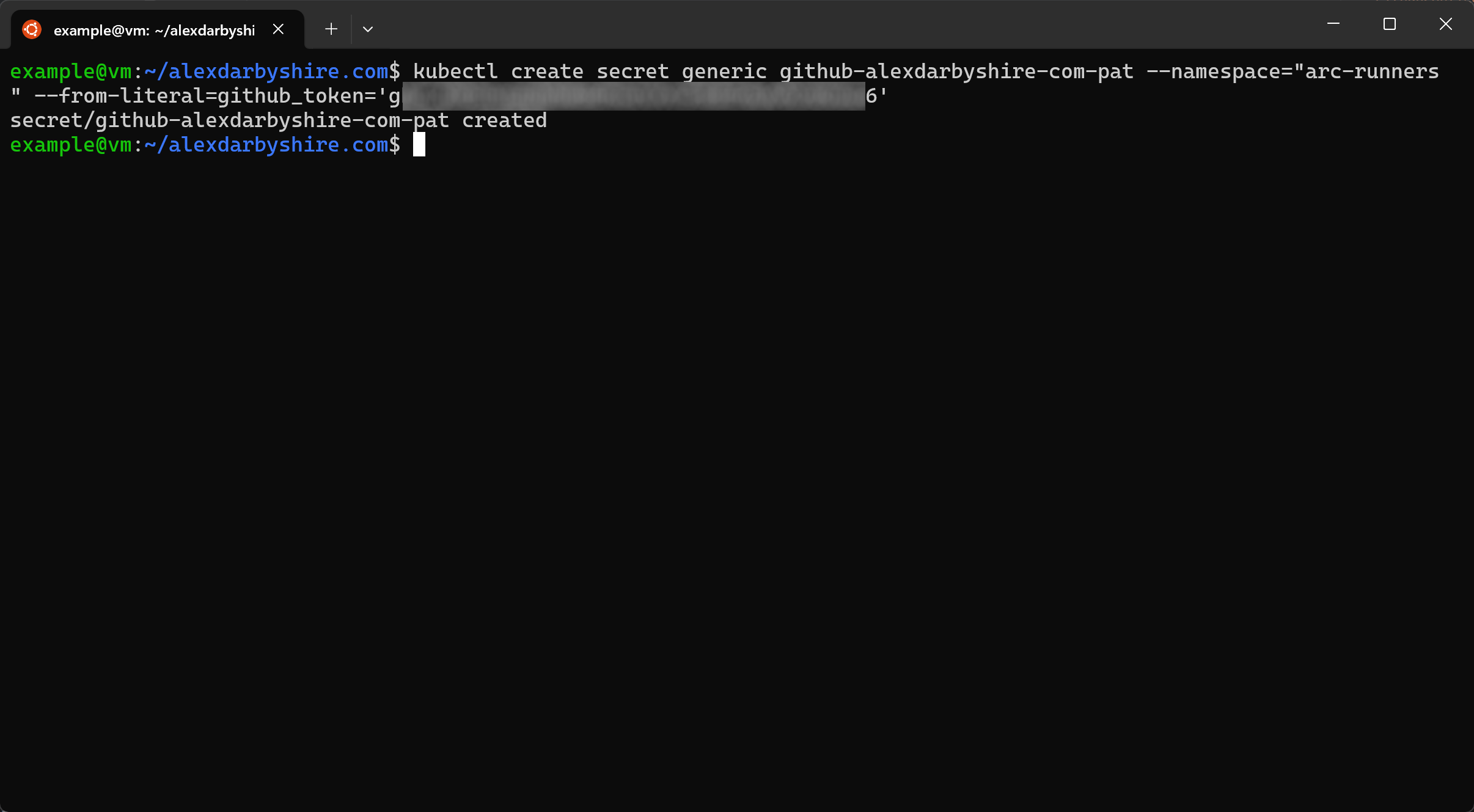 Note the controller looks for the secret in the
Note the controller looks for the secret in the arc-runners namespace with our configuration.
Install ARC Charts#
Install the ARC Controller with this command:
namespace=""
helm install arc \
--namespace "${namespace}" \
--create-namespace \
oci://ghcr.io/actions/actions-runner-controller-charts/gha-runner-scale-set-controller
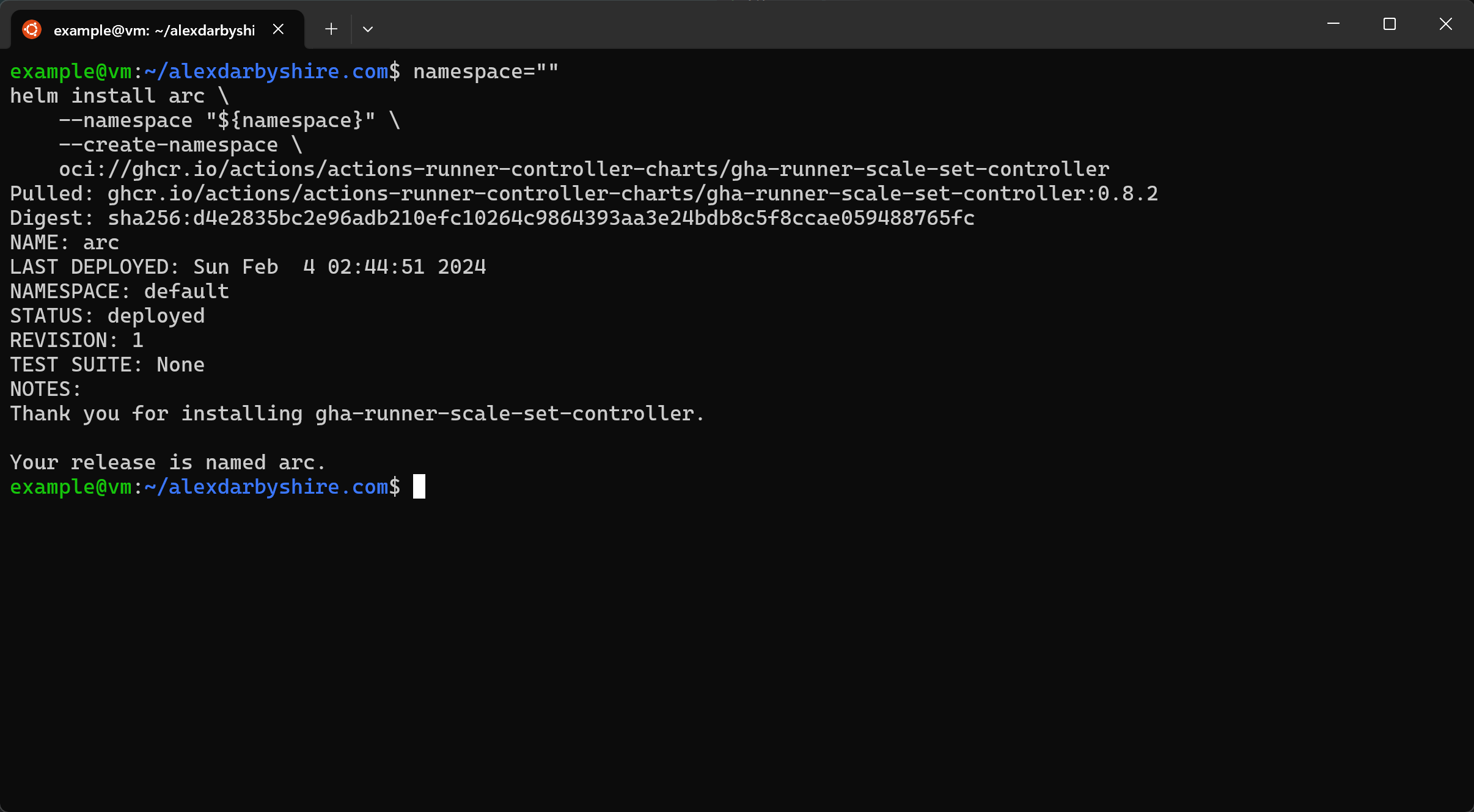
Then install the ARC Runner Set:
INSTALLATION_NAME="arc-runner-set"
NAMESPACE=""
helm install "${INSTALLATION_NAME}" \
--namespace "${NAMESPACE}" \
--create-namespace \
oci://ghcr.io/actions/actions-runner-controller-charts/gha-runner-scale-set \
--values deploy/helm/arc-runner-values.yaml
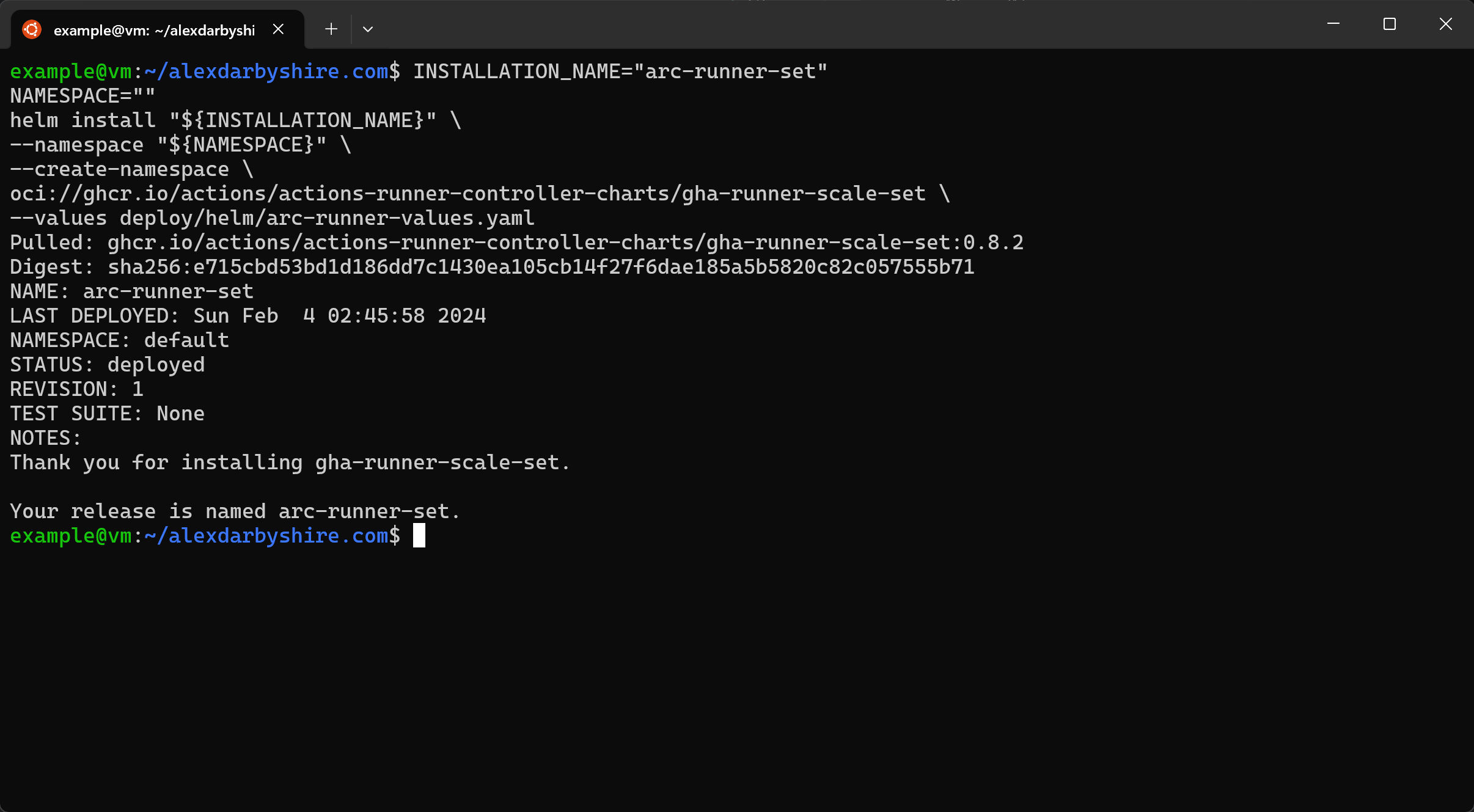
Check ARC Pods are up#
kubectl get pods
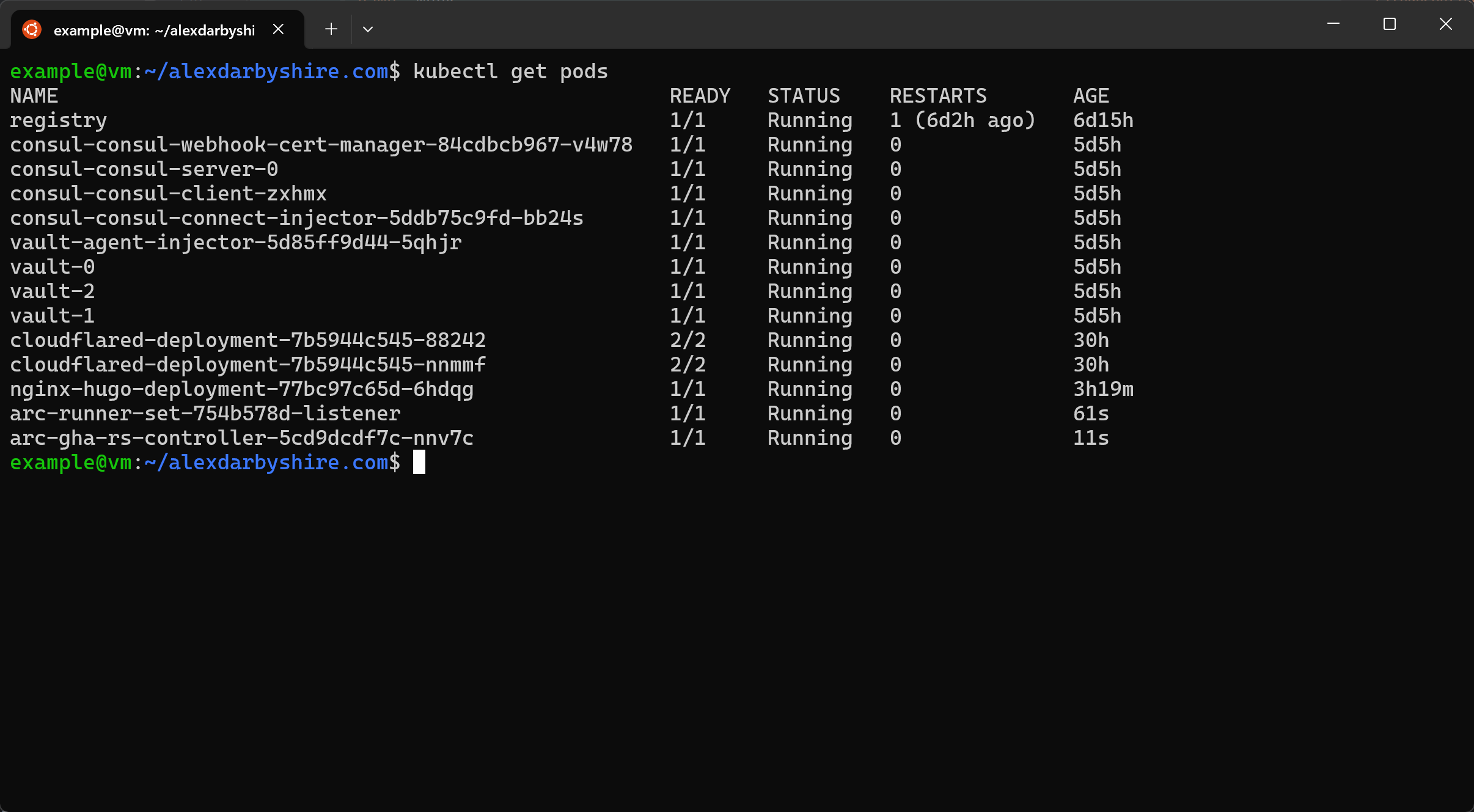
Not up? Check the ARC controller logs. kubectl logs ... where … is the name of the controller pod. Note, if using namespaces and the controller doesn’t have succificient permissions to the Kubernetes API there may not be logs events associated with the runner set not coming up (controller may not be able to ‘see’ the runner set).
Define and Deploy the Workflow#
Create a directory in the repo where GitHub reads workflow definitions from:
mkdir -p .github/workflows/
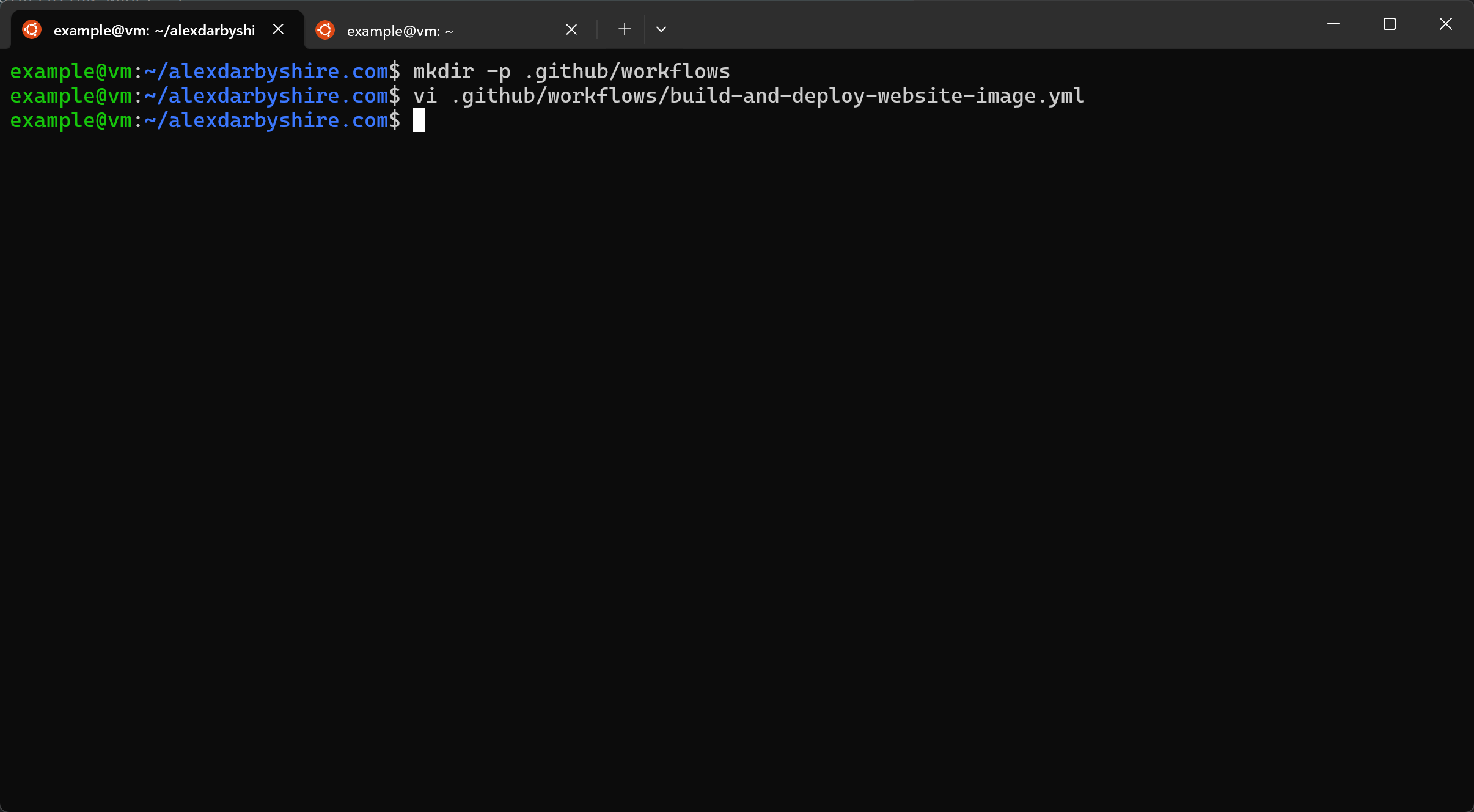
Create a file .github/workflows/build-and-deploy-website-image.yml with contents:
name: Build-and-Deploy-Image
run-name: ${{ github.actor }} is updating alexdarbyshire.com
on:
push:
branches:
- main
env:
IMAGE_TAG: ${{ github.sha }}
IMAGE_NAME: "alexdarbyshire-site"
BASE_URL: "https://www.alexdarbyshire.com"
jobs:
Build-and-Push:
runs-on: arc-runner-set
steps:
- name: Install git in runner
run: |
sudo apt update
sudo apt install -yq git
- name: Check out repository code
uses: actions/checkout@v4
with:
repository: 'alexdarbyshire/alexdarbyshire.com'
submodules: recursive
- name: Set up QEMU
uses: docker/setup-qemu-action@v3
- name: Set up Docker Buildx
uses: docker/setup-buildx-action@v3
with:
config-inline: |
[registry."registry:5000"]
http = true
insecure = true
- name: Build and push to local registry
uses: docker/build-push-action@v5
with:
context: .
build-args: |
HUGO_ENV=production
HUGO_BASEURL=${{ env.BASE_URL }}
push: true
tags: registry:5000/alexdarbyshire-site:${{ github.sha }},registry:5000/alexdarbyshire-site:latest
- name: Inspect
run: |
docker buildx imagetools inspect registry:5000/$IMAGE_NAME:$IMAGE_TAG
Patch-Deployment-Image:
runs-on: arc-runner-set
needs: Build-and-Push
steps:
- name: Install Kubectl
env:
KUBE_VERSION: "v1.29.1"
run: |
sudo apt update
sudo apt install -yq openssl curl ca-certificates
sudo curl -L https://storage.googleapis.com/kubernetes-release/release/$KUBE_VERSION/bin/linux/amd64/kubectl -o /usr/local/bin/kubectl
sudo chmod +x /usr/local/bin/kubectl
- name: Update kubernetes deployment to image
run: |
kubectl patch deployment nginx-hugo-deployment -p \
'{"spec":{"template":{"spec":{"containers":[{"name":"nginx-hugo","image":"localhost:5000/alexdarbyshire-site:'$IMAGE_TAG'"}]}}}}'
This workflow is triggered on push (or merge end) to main branch.
The jobs within collectively:
- check out the code from the
mainbranch of the repo, - build our Dockerfile with the commit SHA as its tag,
- push the image to our local repository, and
- patch our deployment to use the newly built image.
Add, Commit, and Push the Code#
First, check what we will be adding/staging with git status.
git add .
git commit -m 'Add ARC GitHub Runner and website deploy workflow'
git push
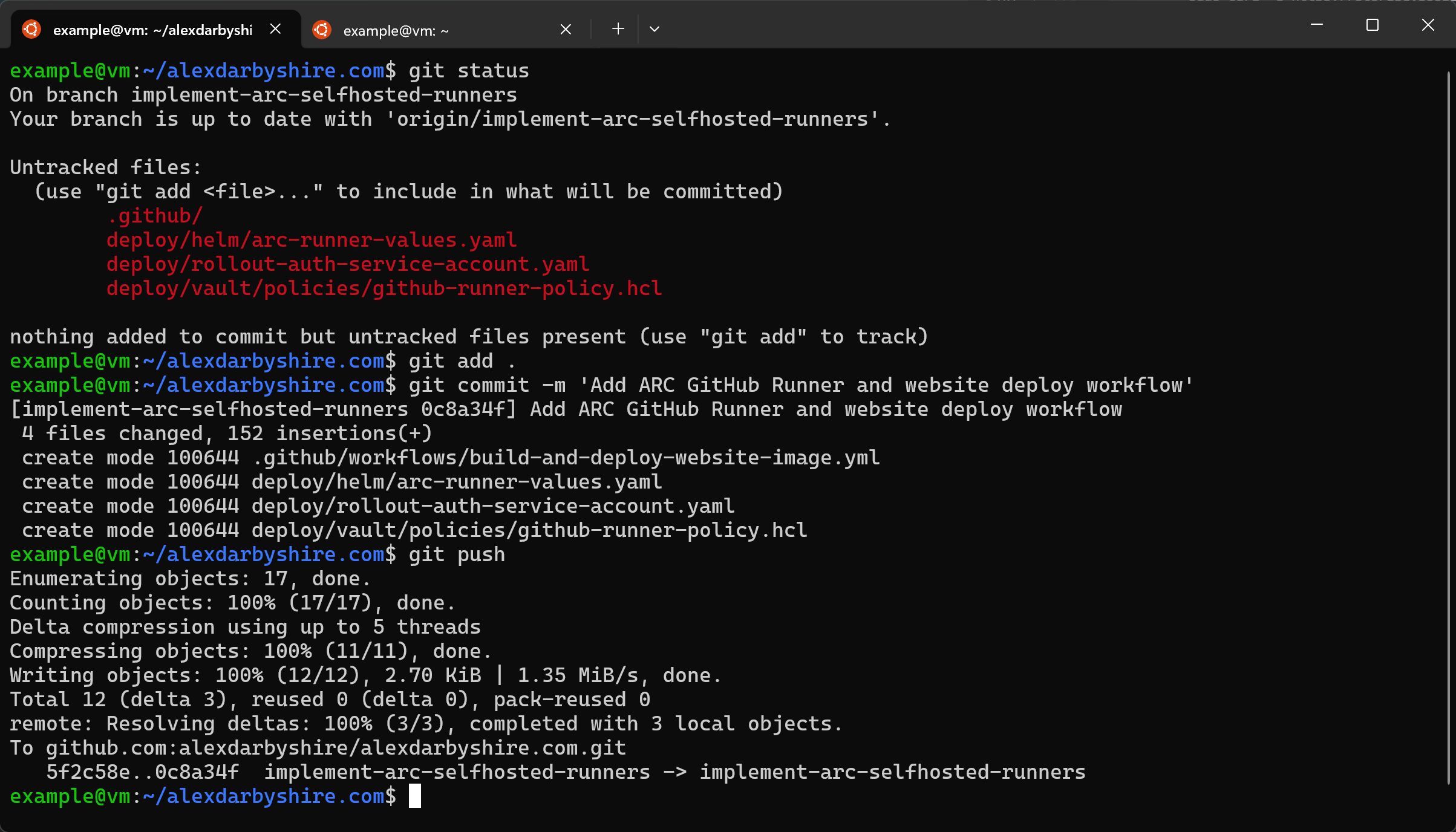 Disregard the branch in this screenshot
Disregard the branch in this screenshot
Confirm Workflow Execution#

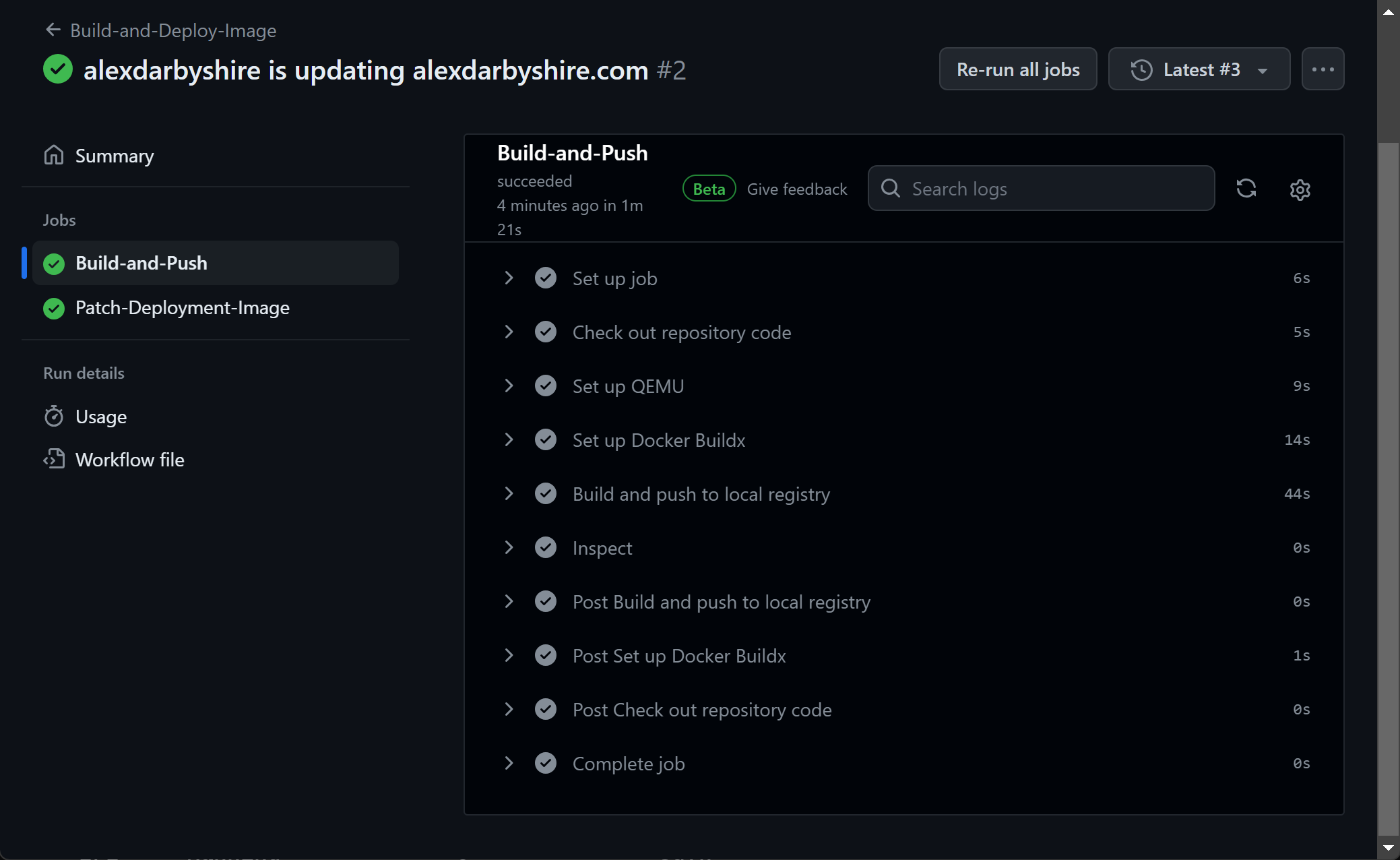
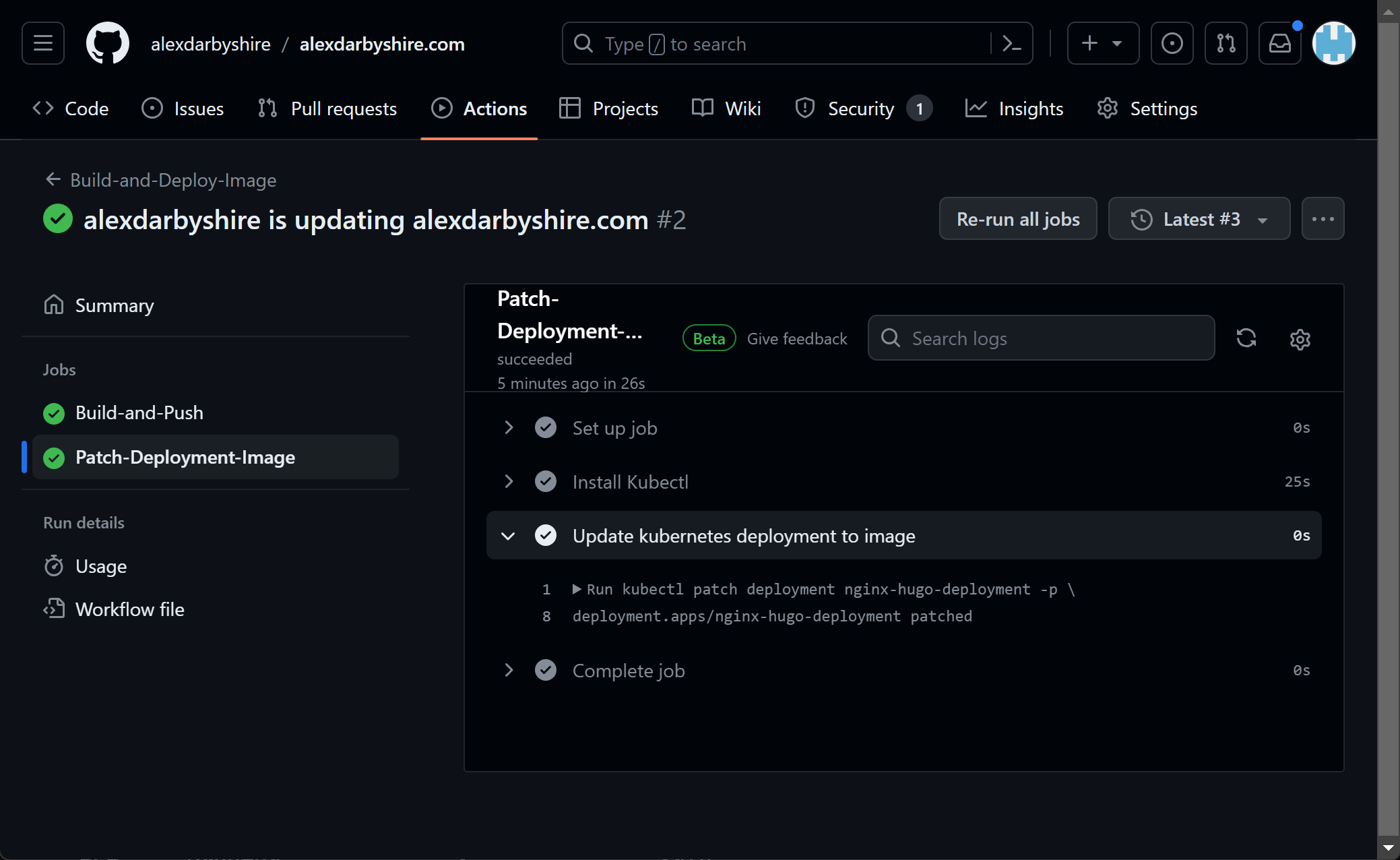
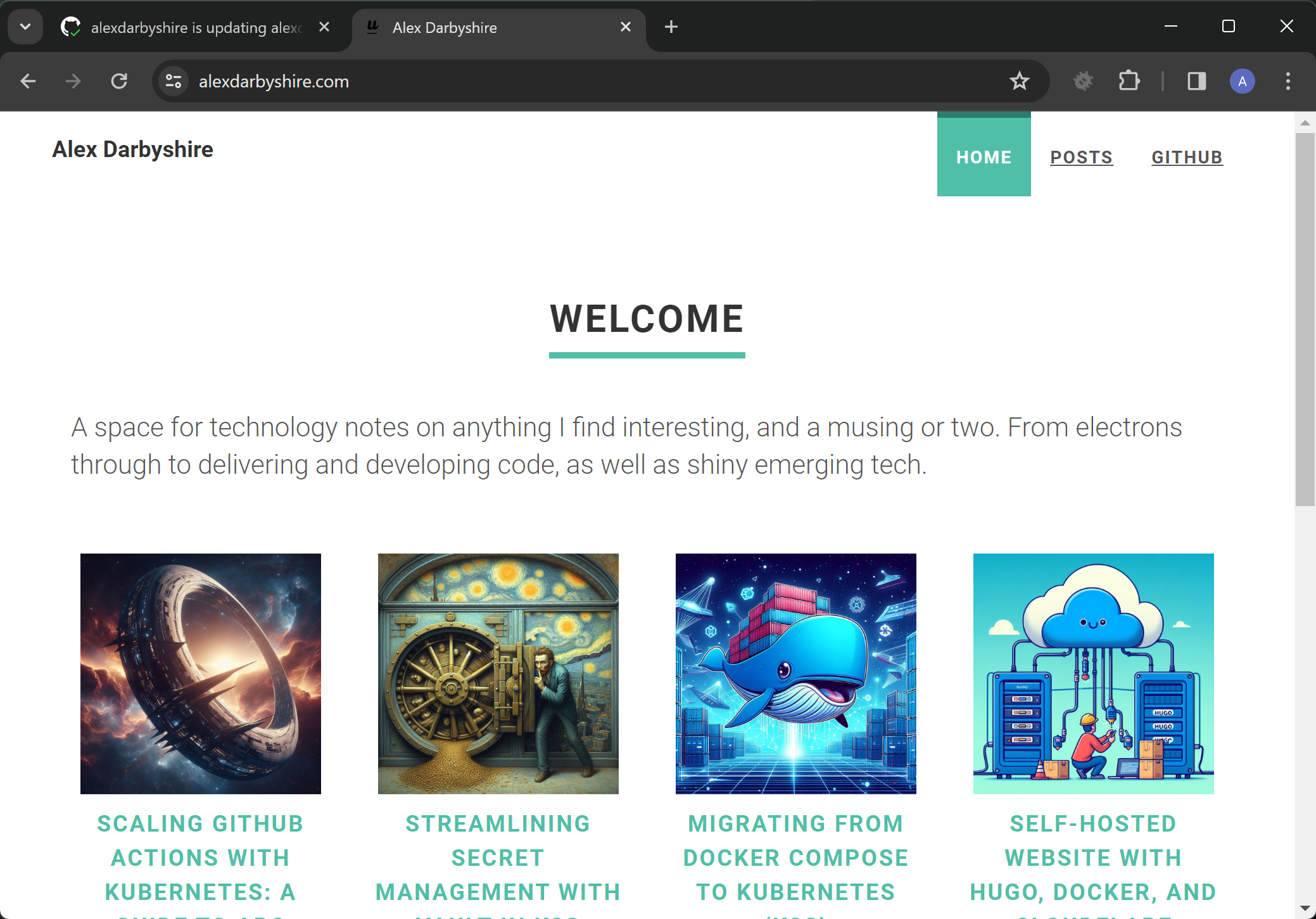 Success!
Success!
Done#
With GitHub Actions setup, perhaps it is time to turn our attention towards improving observability of Kubernetes resources.